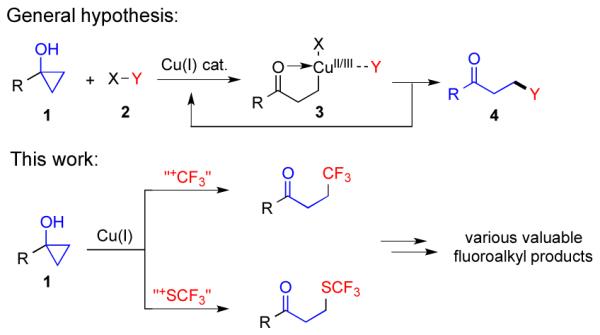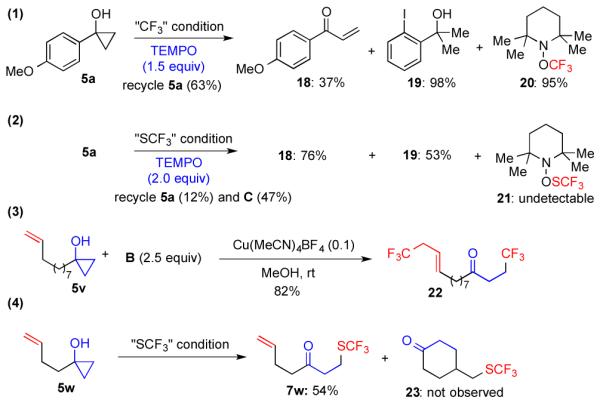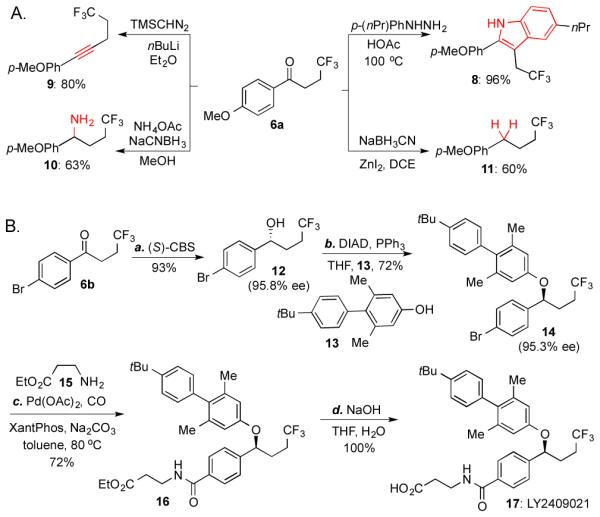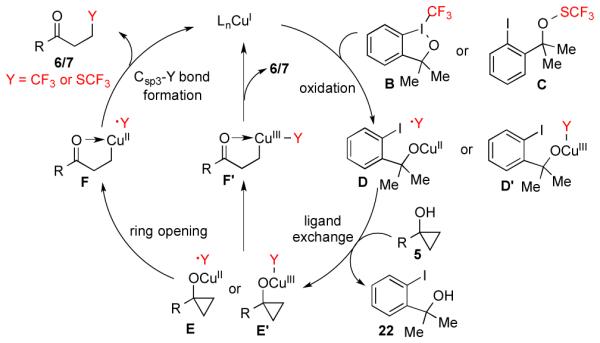Abstract
The first copper-catalyzed ring-opening electrophilic trifluoromethylation and trifluoromethylthiolation of cyclopropanols to form Csp3-CF3 and Csp3-SCF3 bonds have been realized. These transformations are efficient for the synthesis of β-CF3 and β-SCF3 substituted carbonyl compounds that are otherwise challenging to access. The reaction conditions are mild and tolerate a wide range of functional groups. Application to a concise synthesis of LY2409021, a glucagon receptor antagonist that is used in clinical trial for type 2 diabetes mellitus, is reported as well.

Fluorine-containing organic molecules have shown exceptional importance in numerous areas including pharmaceutical industry, agriculture, and material sciences. Among various fluorine-containing groups, trifluoromethyl (CF3) and trifluoromethylthiol (SCF3) groups often appear in life-saving drug molecules as well as agrochemicals. Significant advances have been made recently on installation of CF31 and SCF32 groups on sp2, sp, and activated sp3 (cf. allylic, benzylic, α-carbon of carbonyls) carbons. However, synthetic options for the introduction of these valuable groups on non-activated aliphatic carbons are still very limited.3
Due to their intrinsic ring strain and straightforward synthesis, cyclopropanols have been broadly used as starting materials in various transition metal-mediated or catalyzed ring-opening cross-coupling reactions.4 For example, palladium-catalyzed cyclopropanol ring-opening followed by cross-coupling reactions have been developed to form C-C bonds at the β-position.5 This type of chemistry however, suffers from competitive β-H elimination to form α,β-unsaturated ketone byproducts or requires special substrates or palladium-ligand combinations to ensure the desired C-C bond formation. Despite the low-cost of copper catalyst,6 copper-catalyzed or mediated cyclopropanol ring opening cross-coupling reactions have been very rare.7 We envisioned that cyclopropanols could be converted to various valuable α-substituted carbonyl compounds including α-CF3/SCF3 substituted products via coppercatalyzed ring-opening cross-coupling reactions (Figure 1). In the catalytic cycle, the Cu(I)-catalyst would be oxidized by generic oxidant 2 to generate Cu(II)- or Cu(III)-catalyst, which would then promote ring-opening C-C bond cleavage of cyclopropanols and generate Cu(II) or Cu(III)-homoenolates 3 depending on the nature of the Cu-Y bond. The latter would then undergo Csp3-Y bond formation to provide product 4 and regenerate the Cu(I)-catalyst. This catalytic copperhomoenolate homoenolate cross-coupling chemistry would render cyclopropanols and the related systems as useful alkyl cross-coupling partners to form important Csp3-Csp3 and Csp3-heteroatom bonds.
Figure 1.

General hypothesis and this work.
If electrophilic trifluoromethylation or trifluoromethylthiolation reagents could be used as oxidants, we expected to install CF3 or SCF3 groups at the β-position of saturated carbonyl compounds via copper-catalyzed Csp3-CF3 or Csp3-SCF3 bond formation, respectively (Figure 1, Y = CF3 or SCF3). This method could provide a complimentary and umpolung strategy for synthesizing β-CF3/SCF3 substituted ketones,8 which are otherwise challenging to access via other synthetic methods including the conjugate additions of the corresponding CF3/SCF3 nucleophile to α,β-unsaturated carbonyl systems.9 Due to the rich and diverse chemistry of the carbonyl group, the β-CF3/SCF3 substituted products could be readily converted to many useful fluoroalkyl products as well. While mechanistically interesting and synthetically appealing, the proposed catalytic process from 1 to 4 is very challenging because in order to selectively form the desired Csp3-CF3/SCF3 bond, the following competing side reactions must be suppressed: (i) homodimerization of 3 to form 1,6-diketones,7a (ii) elimination or oxidation to form β,β-unsaturated enones, and (iii) protonation to form ethyl ketones. Herein, we report the first copper-catalyzed electrophilic trifluoromethylation and trifluoromethylthiolation of cyclopropanols to synthesize various β-CF3/SCF3 substituted carbonyl compounds with an application to LY2409021 (17), a glucagon receptor antagonist that is used in clinical trial for type 2 diabetes mellitus.10
We started with cyclopropanol 5a (Figure 2 and the Supporting Information, Table 1). When it was treated with the first generation Togni reagent A derived from 2-iodobenzoic acid11 in MeOH with catalytic amount of Cu(MeCN)4BF4, desired β-CF3 ketone 6a was produced in 40% yield but accompanied with significant amount of β-iodoketone and α,β-unsaturated ketone byproducts. Further reaction optimization did show that Togni reagent B is effective to suppress the formation of these byproducts. Cationic copper catalyst is necessary for high yield in comparison to CuCl, CuBr and CuTc. Increasing the amount of reagent B to 1.5 equiv is beneficial, but further increase results in more unidentified byproducts. Overall, we were able to obtain desired β-CF3 ketone product 6a in 90% yield with optimized reaction conditions. The reaction does not take place in the absence of copper-catalyst.
Figure 2.
Substrate scope for trifluoromethylationa. [a]Isolated yield otherwise noted; [b]0.64 gram of 6a produced; [c]Yield based on 19F NMR.
We then showed that this reaction is very general and tolerates a wide range of functional groups (Figure 2). Both aryl and alkyl substituted cyclopropanols worked smoothly to provide the desired β-CF3 ketones in good to excellent yield. Bromide (6b), aryl and alkyl ether (6a, 6d, 6g), ester (6h), primary and secondary TBS-ether (6i and 6s), tosyl (6j), epoxide (6k), α,β-unsaturated ester/aldehyde (6l, 6m), alcohol (6o) and amide (6n) functional groups are also compatible with the reaction conditions. Notably, β-CF3 aldehyde could be synthesized in good yield as well (6r). When cyclopropanol 5t was used, a 2.4/1 mixture of products 6ta and 6tb were produced slightly favoring product 6ta. The reaction is amenable for scale up; 6a could be produced in a 0.64 gram in 93% yield.
We then wondered whether this new catalytic cycle could be transferred to make β-SCF3 substituted ketones. While simply replacing Togni reagent B with other electrophilic SCF3-reagents did not give satisfactory outcome, we were able to quickly optimize the reaction (see the Supporting Information, Table 2) and found that β-SCF3 substituted ketones could be prepared in good to excellent yield with CuSCF3 (0.1 equiv), bipyridine (0.2 equiv), 2.0 equiv of reagent C12 in DMSO at room temperature. CuSCF3 is superior to other copper catalysts because it avoided the introduction of other noninnocent anionic counterions to complicate the cross coupling process. Again, the substrate scope of this reaction is broad and many functional groups are compatible with the mild reaction conditions (Figure 3). Notably, terminal olefins that are incompatible in the β-trifluoromethylation conditions (Figure 5, 5v→22) are well tolerated in the trifluoromethylthiolation conditions (cf. 7v).
Figure 3.
Substrate scope for trifluoromethylthiolation.
Figure 5.

Preliminary probe of reaction mechanisms.
The β-CF3/SCF3 substituted ketone products could be readily converted to other valuable CF3/SCF3-containing compounds (Figure 4A and the Supporting Information, Figure 1 and 2). For example, 6a could be transformed to indole 8 via Fisher indole synthesis, alkyne 9 via a one-carbon homologation, or amine 10 via reductive amination reaction. It could be reduced to 11 as well, which renders the carbonyl group derived from cyclopropanol a traceless group. Similar synthetic transformations could be conducted on the corresponding β-SCF3 substituted carbonyl products as well (see the Supporting Information, Figure 2). We then applied the trifluoromethylation reaction to synthesize a therapeutic candidate LY2409021 (Figure 4B). LY2409021 is a glucagon receptor antagonist that is currently used in clinical trial for type 2 diabetes mellitus. Its CF3-containing alkyl chain has been shown to be critical for its activity. Our synthesis started with β-CF3 ketone 6b. After CBS-reduction and Mitsunobu reaction with 13, 6b was converted to 14 in excellent yield and enantioselectivity. The bromide group of 14 then served as a convenient handle to synthesize 16 via a palladium-catalyzed carbonylative amination reaction.13 The latter was then converted to LY2409021 (17) upon hydrolysis.
Figure 4.

Representative transformation of β-CF3 substituted ketones and an efficient synthesis of LY2409021.
To gain information about the reaction mechanism, we investigated the effect of TEMPO on both the trifluoromethylation and trifluoromethylthiolation reactions (Figure 5). Very different results were obtained when a 1/1 ratio of TEMPO to B/C were added. For the trifluoromethylation reaction, TEMPO-CF3 (20) was obtained in 95% yield with 98% yield of 19, 37% yield of 18 as well as 63% recovery of 5a recycled. The formation of 20 indicates the involvement of CF3 radical, which was supported by the conversion of cyclopropanol 5v with a terminal olefin to double trifluoromethylated product 22.14 In the case of trifluoromethylthiolation, no TEMPO-SCF3 (21) was obtained. When substrate 5w was used in the trifluoromethylthiolation reaction, 7w was produced in 54% yield and the terminal olefin is tolerated under the reaction conditions. In this case, no cyclized product 23 was observed, indicating that copper-promoted radical cyclopropanol ring-opening process to produce an β-alkyl radical was unlikely15 and copper-promoted β-carbon elimination might be involved to generate a copper-homoenolate. When enone 18 was subjected to the trifluoromethylation or trifluoromethylthiolation reaction, no 6a or 7a were obtained respectively, which suggest that α,β-unsaturated ketone intermediate is not involved in the production of the desired product.
With these preliminary observations, a mechanistic model involving several plausible pathways was proposed (Figure 6). One posibility is that the reactions may proceed with oxidation of Cu(I)-catalyst by reagent B/C to form a Cu(II)-intermediate D as well as the CF3/SCF3 radical.14 Intermediate D would then undergo ligand exchange with cyclopropanol 5 to form E, which would proceed with cyclopropane ring C-C bond cleavage to provide homoenolate F.7a,7b Csp3-Y bond formation from F would produce product 6/7 and regenerate Cu(I)-catalyst. At this stage, the possibility of involving Cu(III) intermediates (cf. B/C→D’→E’→F’→6/7) can not be ruled out. Since distinct patterns of reactivity have been observed, the trifluoromethylation and trifluoromethylthiolation reactions may proceed in different pathways as well and further studies are necessary to understand these processes
Figure 6.

Proposed catalytic cycle.
In summary, the first Cu-catalyzed trifluoromethylation and trifluoromethylthiolation of cyclopropanols have been developed to synthesize β-CF3/SCF3 substituted carbonyl compounds. The reaction conditions are mild and compatible with a wide range of functional groups. The products can be readily transformed to many other useful CF3/SCF3-containing compounds which are otherwise difficult to access. Their potential application has been demonstrated by preparing LY2409021, a clinical drug for type 2 diabetes mellitus. While the detailed reaction mechanisms have not yet been understood, these two novel catalytic reaction modes of copper-homoenolate chemistry render cyclopropanol and related systems valuable alkyl cross-coupling partners and open new gates for discovering new reactivity and reaction modes for Csp3-Csp3 or Csp3-heteroatom bond formations.
Supplementary Material
ACKNOWLEDGMENT
We thank the Xia group at Purdue University for assistance with mass spectrometry, Dr. Philip Hipskind at Eli Lilly and Company for discussions, the NIH for supporting shared NMR resources to the Purdue Center for Cancer Research (P30CA023168), and the support from the ACS Petroleum Research Foundation (PRF# 54896-DNI1).
Footnotes
Supporting Information
Experimental procedures and characterization for new compounds are provided. This material is available free of charge via the Internet at http://pubs.acs.org.
Notes
The authors declare no competing financial interests.
REFERENCES
- (1).(a) Ma J-A, Cahard D. Chem. Rev. 2008;108:PR1. doi: 10.1021/cr800221v. For reviews: [DOI] [PubMed] [Google Scholar]; (b) Furuya T, Kamlet AS, Ritter T. Nature. 2011;473:470. doi: 10.1038/nature10108. [DOI] [PMC free article] [PubMed] [Google Scholar]; (c) Liang T, Neumann CN, Ritter T. Angew. Chem. Int. Ed. 2013;52:8214. doi: 10.1002/anie.201206566. [DOI] [PubMed] [Google Scholar]; (d) Ni C, Hu M, Hu J. Chem. Rev. 2015;115:765. doi: 10.1021/cr5002386. [DOI] [PubMed] [Google Scholar]; (e) Tomashenko OA, Grushin VV. Chem. Rev. 2011;111:4475. doi: 10.1021/cr1004293. [DOI] [PubMed] [Google Scholar]; (f) Studer A. Angew. Chem. Int. Ed. 2012;51:8950. doi: 10.1002/anie.201202624. [DOI] [PubMed] [Google Scholar]; (g) Cho EJ, Senecal TD, Kinzel T, Zhang Y, Watson DA, Buchwald SL. Science. 2010;328:1679. doi: 10.1126/science.1190524. [DOI] [PMC free article] [PubMed] [Google Scholar]; (h) Ball ND, Gary JB, Ye Y, Sanford MS. J. Am. Chem. Soc. 2011;133:7577. doi: 10.1021/ja201726q. [DOI] [PMC free article] [PubMed] [Google Scholar]; (i) Zhang X-G, Dai H-X, Wasa M, Yu J-Q. J. Am. Chem. Soc. 2012;134:11948. doi: 10.1021/ja305259n. [DOI] [PubMed] [Google Scholar]; (j) Nebra N, Grushin VV. J. Am. Chem. Soc. 2014;136:16998. doi: 10.1021/ja5103508. [DOI] [PubMed] [Google Scholar]; (k) Dubinina GG, Furutachi H, Vicic DA. J. Am. Chem. Soc. 2008;130:8600. doi: 10.1021/ja802946s. [DOI] [PubMed] [Google Scholar]; (l) Morimoto H, Tsubogo T, Litvinas ND, Hartwig JF. Angew. Chem. Int. Ed. 2011;50:3793. doi: 10.1002/anie.201100633. [DOI] [PMC free article] [PubMed] [Google Scholar]; (m) Chu L, Qing F-L. J. Am. Chem. Soc. 2010;132:7262. doi: 10.1021/ja102175w. [DOI] [PubMed] [Google Scholar]; (n) Nagib DA, MacMillan DWC. Nature. 2011;480:224. doi: 10.1038/nature10647. [DOI] [PMC free article] [PubMed] [Google Scholar]; (o) Allen AE, MacMillan DWC. J. Am. Chem. Soc. 2010;132:4986. doi: 10.1021/ja100748y. [DOI] [PMC free article] [PubMed] [Google Scholar]; (p) Früh N, Togni A. Angew. Chem. Int. Ed. 2014;53:10813. doi: 10.1002/anie.201406181. [DOI] [PubMed] [Google Scholar]; (q) He Z, Zhang R, Hu M, Li L, Ni C, Hu J. Chem. Sci. 2013;4:3478. [Google Scholar]; (r) Lu D-F, Zhu C-L, Xu H. Chem. Sci. 2013;4:2478. [Google Scholar]; (s) Ramachandran PV, Parthasarathy G, Gagare PD. Org. Lett. 2010;12:4474. doi: 10.1021/ol1016178. [DOI] [PubMed] [Google Scholar]; (t) Li L, Chen Q-Y, Guo Y. J. Org. Chem. 2014;79:5145. doi: 10.1021/jo500713f. [DOI] [PubMed] [Google Scholar]; (u) Zhu L, Liu S, Douglas JT, Altman RA. Chem. Eur. J. 2013;19:12800. doi: 10.1002/chem.201302328. [DOI] [PubMed] [Google Scholar]; (v) Ji Y, Brueckl T, Baxter RD, Fujiwara Y, Seiple IB, Su S, Blackmond DG, Baran PS. Proc. Natl. Acad. Sci. USA. 2011;108:14411. doi: 10.1073/pnas.1109059108. [DOI] [PMC free article] [PubMed] [Google Scholar]
- (2).(a) Leroux F, Jeschke P, Schlosser M. Chem. Rev. 2005;105:827. doi: 10.1021/cr040075b. For reviews: [DOI] [PubMed] [Google Scholar]; (b) Manteau B, Pazenok S, Vors J-P, Leroux FR. J. Fluorine Chem. 2010;131:140. [Google Scholar]; (c) Xu X-H, Matsuzaki K, Shibata N. Chem. Rev. 2015;115:731. doi: 10.1021/cr500193b. [DOI] [PubMed] [Google Scholar]; (d) Baert F, Colomb J, Billard T. Angew. Chem. Int. Ed. 2012;51:10382. doi: 10.1002/anie.201205156. [DOI] [PubMed] [Google Scholar]; (e) Teverovskiy G, Surry DS, Buchwald SL. Angew. Chem. Int. Ed. 2011;50:7312. doi: 10.1002/anie.201102543. [DOI] [PMC free article] [PubMed] [Google Scholar]; (f) Tran LD, Popov I, Daugulis O. J. Am. Chem. Soc. 2012;134:18237. doi: 10.1021/ja3092278. [DOI] [PMC free article] [PubMed] [Google Scholar]; (g) Danoun G, Bayarmagnai B, Gruenberg MF, Goossen LJ. Chem. Sci. 2014;5:1312. [Google Scholar]; (h) Hu M, Rong J, Miao W, Ni. C.; Han Y, Hu J. Org. Lett. 2014;16:2030. doi: 10.1021/ol500612n. [DOI] [PubMed] [Google Scholar]; (i) Chen C, Chu L, Qing F-L. J. Am. Chem. Soc. 2012;134:12454. doi: 10.1021/ja305801m. [DOI] [PubMed] [Google Scholar]; (j) Chen C, Xu X-H, Yang B, Qing F-L. Org. Lett. 2014;16:3372. doi: 10.1021/ol501400u. [DOI] [PubMed] [Google Scholar]; (k) Pluta R, Nikolaienko P, Rueping M. Angew. Chem. Int. Ed. 2014;53:1650. doi: 10.1002/anie.201307484. [DOI] [PubMed] [Google Scholar]; (l) Bootwicha T, Liu X, Pluta R, Atodiresei I, Rueping M. Angew. Chem. Int. Ed. 2013;52:12856. doi: 10.1002/anie.201304957. [DOI] [PubMed] [Google Scholar]; (m) Hu F, Shao X, Zhu D, Lu L, Shen Q. Angew. Chem. Int. Ed. 2014;53:6105. doi: 10.1002/anie.201402573. [DOI] [PubMed] [Google Scholar]; (n) Xu C, Ma B, Shen Q. Angew. Chem. Int. Ed. 2014;53:9316. doi: 10.1002/anie.201403983. [DOI] [PubMed] [Google Scholar]; (o) Yang Y-D, Azuma A, Tokunaga E, Yamasaki M, Shiro M, Shibata N. J. Am. Chem. Soc. 2013;135:8782. doi: 10.1021/ja402455f. [DOI] [PubMed] [Google Scholar]; (p) Zhang C-P, Vicic DA. J. Am. Chem. Soc. 2012;134:183. doi: 10.1021/ja210364r. [DOI] [PubMed] [Google Scholar]; (q) Wang X, Zhou Y, Ji G, Wu G, Li M, Zhang Y, Wang J. Eur. J. Org. Chem. 2014:3093. [Google Scholar]; (r) Huang Y, He X, Lin X, Rong M, Weng Z. Org. Lett. 2014;16:3284. doi: 10.1021/ol501290p. [DOI] [PubMed] [Google Scholar]; (s) Weng Z, He W, Chen X, Lee R, Tan D, Lai Z, Kong D, Yuan Y, Huang K-W. Angew. Chem. Int. Ed. 2013;52:1548. doi: 10.1002/anie.201208432. [DOI] [PubMed] [Google Scholar]; (t) Li S-G, Zard SZ. Org. Lett. 2013;15:5898. doi: 10.1021/ol403038f. [DOI] [PubMed] [Google Scholar]; (u) Ye K-Y, Zhang X, Dai L-X, You S-L. J. Org. Chem. 2014;79:12106. doi: 10.1021/jo5019393. [DOI] [PubMed] [Google Scholar]
- (3).(a) Xu J, Liu X, Fu Y. Tetrahedron Lett. 2014;55:585. For a review: [Google Scholar]; (b) Xu J, Xiao B, Xie C-Q, Luo D-F, Liu L, Fu Y. Angew. Chem. Int. Ed. 2012;51:12551. doi: 10.1002/anie.201206681. For examples: [DOI] [PubMed] [Google Scholar]; (c) Shimizu R, Egami H, Hamashima Y, Sodeoka M. Angew. Chem. Int. Ed. 2012;51:4577. doi: 10.1002/anie.201201095. [DOI] [PubMed] [Google Scholar]; (d) Yasu Y, Koike T, Akita M. Angew. Chem. Int. Ed. 2012;51:9567. doi: 10.1002/anie.201205071. [DOI] [PubMed] [Google Scholar]; (e) Janson PG, Ghoneim I, Ilchenko NO, Szabó KJ. Org. Lett. 2012;14:2882. doi: 10.1021/ol3011419. [DOI] [PubMed] [Google Scholar]; (f) Argintaru OA, Ryu D, Aron I, Molander GA. Angew. Chem. Int. Ed. 2013;52:13656. doi: 10.1002/anie.201308036. [DOI] [PMC free article] [PubMed] [Google Scholar]; (g) Mizuta S, Verhoog S, Engle KM, Khotavivattana T, O’Duill M, Wheelhouse K, Rassias G, Médebielle M, Gouverneur V. J. Am. Chem. Soc. 2013;135:2505. doi: 10.1021/ja401022x. [DOI] [PubMed] [Google Scholar]; (h) Feng C, Loh T-P. Chem. Sci. 2012;3:3458. [Google Scholar]; (i) Ferry A, Billard T, Langlois BR, Bacqué E. Angew. Chem. Int. Ed. 2009;48:8551. doi: 10.1002/anie.200903387. [DOI] [PubMed] [Google Scholar]; (j) Liu J-B, Xu X-H, Chen Z-H, Qing F-L. Angew. Chem. Int. Ed. 2015;54:897. doi: 10.1002/anie.201409983. [DOI] [PubMed] [Google Scholar]; (k) Hu F, Shao X, Zhu D, Lu L, Shen Q. Angew. Chem. Int. Ed. 2014;53:6105. doi: 10.1002/anie.201402573. [DOI] [PubMed] [Google Scholar]; (l) Shao X, Liu T, Lu L, Shen Q. Org. Lett. 2014;16:4738. doi: 10.1021/ol502132j. [DOI] [PubMed] [Google Scholar]; (m) Guo S, Zhang X, Tang P. Angew. Chem. Int. Ed. 2015;54:4065. doi: 10.1002/anie.201411807. [DOI] [PubMed] [Google Scholar]
- (4).(a) Gibson DH, DePuy CH. Chem. Rev. 1974;74:605. For reviews: [Google Scholar]; (b) Ryu I, Murai S. Houben-Weyl Methods of Organic Chemistry; Thieme: Stuttgart. 1997;E17c:1985. [Google Scholar]; (c) Kulinkovich OG. Chem. Rev. 2003;103:2597. doi: 10.1021/cr010012i. [DOI] [PubMed] [Google Scholar]
- (5).(b) Rosa D, Nithiy N, Orellana A, Aoki S, Fujimura T, Nakamura E, Kuwajima I. Synthesis. J. Am. Chem. Soc. 2013;1988;45110:3296. For a review: For examples: [Google Scholar]; (c) Fujimura T, Aoki S, Nakamura E. J. Org. Chem. 1991;56:2809. [Google Scholar]; (d) Aoki S, Nakamura E. Synlett. 1990:741. [Google Scholar]; (e) Kang S-K, Yamaguchi T, Ho P-S, Kim W-Y, Yoon S-K. Tetrahedron Lett. 1997;38:1947. [Google Scholar]; (f) Rosa D, Orellana A. Org. Lett. 2011;13:110. doi: 10.1021/ol1026409. [DOI] [PubMed] [Google Scholar]; (g) Rosa D, Orellana A. Chem. Commun. 2012;48:1922. doi: 10.1039/c2cc16758a. [DOI] [PubMed] [Google Scholar]; (h) Parida BB, Das PP, Niocel M, Cha JK. Org. Lett. 2013;15:1780. doi: 10.1021/ol400666x. [DOI] [PubMed] [Google Scholar]; (i) Cheng K, Walsh PJ. Org. Lett. 2013;15:2298. doi: 10.1021/ol4008876. [DOI] [PubMed] [Google Scholar]; (j) Rosa D, Orellana A. Chem. Commun. 2013;49:5420. doi: 10.1039/c3cc42080a. [DOI] [PubMed] [Google Scholar]; (k) Nithiy N, Orellana A. Org. Lett. 2014;16:5854. doi: 10.1021/ol5027188. [DOI] [PubMed] [Google Scholar]
- (6).Krause N. Modern Organocopper Chemistry. Wiley; Hoboken: 2002. [Google Scholar]
- (7) Ryu I, Ando M, Ogawa A, Murai S, Sonoda N. J. Am. Chem. Soc. 1983;105:7192. (a) [Google Scholar]; (b) Ryu I, Matsumoto K, Kameyama Y, Ando M, Kusumoto N, Ogawa A, Kambe N, Murai S, Sonoda N. J. Am. Chem. Soc. 1993;115:12330. [Google Scholar]; (c) Das PP, Belmore K, Cha JK. Angew. Chem. Int. Ed. 2012;51:9517. doi: 10.1002/anie.201205190. [DOI] [PubMed] [Google Scholar]; (d) Rao NN, Parida BB, Cha JK. Org. Lett. 2014;16:6208. doi: 10.1021/ol503136s. [DOI] [PubMed] [Google Scholar]
- (8).(a) Gao B, Zhao Y, Hu J. Angew. Chem. Int. Ed. 2015;54:638. doi: 10.1002/anie.201409705. For examples: [DOI] [PubMed] [Google Scholar]; (b) Gao P, Shen Y-W, Fang R, Hao X-H, Qiu Z-H, Yang F, Yan X-B, Wang Q, Gong X-J, Liu X-Y, Liang Y-M. Angew. Chem. Int. Ed. 2014;53:7629. doi: 10.1002/anie.201403383. [DOI] [PubMed] [Google Scholar]; (c) Mu X, Wu T, Wang H-Y, Guo Y-L, Liu G. J. Am. Chem. Soc. 2012;134:878. doi: 10.1021/ja210614y. [DOI] [PubMed] [Google Scholar]; (d) Wang F, Qi X, Liang Z, Chen P, Liu G. Angew. Chem. Int. Ed. 2014;53:1881. doi: 10.1002/anie.201309991. [DOI] [PubMed] [Google Scholar]; (e) Chen Z-M, Bai W, Wang S-H, Yang B-M, Tu Y-Q, Zhang F-M. Angew. Chem. Int. Ed. 2013;52:9781. doi: 10.1002/anie.201304557. [DOI] [PubMed] [Google Scholar]; (f) Liu X, Xiong F, Huang X, Xu L, Li P, Wu X. Angew. Chem. Int. Ed. 2013;52:6962. doi: 10.1002/anie.201302673. [DOI] [PubMed] [Google Scholar]; (g) Matoba K, Kawai H, Furukawa T, Kusuda A, Tokunaga E, Nakamura S, Shiro M, Shibata N. Angew. Chem. Int. Ed. 2010;49:5762. doi: 10.1002/anie.201002065. [DOI] [PubMed] [Google Scholar]; (h) Prakash GKS, Krishnamurti R, Olah GA. J. Am. Chem. Soc. 1989;111:393. [Google Scholar]; (i) Li L, Guo J-Y, Liu X-G, Shen S, Wang Y, Tan B, Liu X-Y. Org. Lett. 2014;16:6032. doi: 10.1021/ol503067g. [DOI] [PubMed] [Google Scholar]; (j) Kwiatkowski P, Cholewiak A, Kasztelan A. Org. Lett. 2014;16:5930. doi: 10.1021/ol502941d. [DOI] [PubMed] [Google Scholar]; (k) Feng C, Loh T-P. Angew. Chem. Int. Ed. 2013;52:12414. doi: 10.1002/anie.201307245. [DOI] [PubMed] [Google Scholar]; (l) Yin F, Wang X-S. Org. Lett. 2014;16:1128. doi: 10.1021/ol403739w. [DOI] [PubMed] [Google Scholar]; (n) Lerch MM, Morandi B, Wickens ZK, Grubbs RH. Angew. Chem. Int. Ed. 2014;53:8654. doi: 10.1002/anie.201404712. [DOI] [PubMed] [Google Scholar]
- (9).Prakash GKS, Krishnamurti R, Olah GA. J. Am. Chem. Soc. 1989;111:393. [Google Scholar]
- (10).(a) Conner SE, Zhu G, Li J. 2005 Dec;29 WO 2005/123668 A1. [Google Scholar]; (b) Guan H-P, Castro-Perez JM, Davis HR, Engel SS, Johns DG, Lin S, Previs SF, Roddy TP, Wang L, Wang S-P, Xiang Y. 2014 Jun 19;A1 WO 2014/093189. [Google Scholar]
- (11).Matousek V, Pietrasiak E, Schwenk R, Togni A. J. Org. Chem. 2013;78:6763. doi: 10.1021/jo400774u. [DOI] [PubMed] [Google Scholar]
- (12).Shao. X.; Wang X, Yang T, Lu L, Shen Q. Angew. Chem. Int. Ed. 2013;52:3457. doi: 10.1002/anie.201209817. [DOI] [PubMed] [Google Scholar]; (b) Vinogradova EV, Müller P, Buchwald SL. Angew. Chem. Int. Ed. 2014;53:3125. doi: 10.1002/anie.201310897. [DOI] [PMC free article] [PubMed] [Google Scholar]
- (13).Martinelli JR, Watson DA, Freckmann DMM, Barder TE, Buchwald SL. J. Org. Chem. 2008;73:7102. doi: 10.1021/jo801279r. [DOI] [PMC free article] [PubMed] [Google Scholar]
- (14).(a) Parsons AT, Buchwald SL. Angew. Chem. Int. Ed. 2011;50:9120. doi: 10.1002/anie.201104053. [DOI] [PMC free article] [PubMed] [Google Scholar]; (b) Xu J, Fu Y, Luo D-F, Jiang Y-Y, Xiao B, Liu Z-J, Gong T-J, Liu L. J. Am. Chem. Soc. 2011;133:15300. doi: 10.1021/ja206330m. [DOI] [PubMed] [Google Scholar]; (c) Wang X, Ye Y, Zhang S, Feng J, Xu Y, Zhang Y, Wang J. J. Am. Chem. Soc. 2011;133:16410. doi: 10.1021/ja207775a. [DOI] [PubMed] [Google Scholar]; (d) Wang F, Wang D, Mu X, Chen P, Liu G. J. Am. Chem. Soc. 2014;136:10202. doi: 10.1021/ja504458j. [DOI] [PubMed] [Google Scholar]; (e) Yu P, Lin J-S, Li L, Zheng S-C, Xiong Y-P, Zhao L-J, Tan B, Liu X-Y. Angew. Chem. Int. Ed. 2014;53:11890. doi: 10.1002/anie.201405401. [DOI] [PubMed] [Google Scholar]
- (15).(a) Hasegawa E, Tateyama M, Nagumo R, Tayama E, Iwamoto H. Beilstein J. Org. Chem. 2013;9:1397. doi: 10.3762/bjoc.9.156. [DOI] [PMC free article] [PubMed] [Google Scholar]; (b) Snider BB, Kwon T. J. Org. Chem. 1992;57:2399. [Google Scholar]; (c) Wang Y-F, Toh KK, Ng EPJ, Chiba S. J. Am. Chem. Soc. 2011;133:6411. doi: 10.1021/ja200879w. [DOI] [PubMed] [Google Scholar]; (d) Zhao H, Fan X, Yu J, Zhu C. 2015;137:3490. doi: 10.1021/jacs.5b00939. [DOI] [PubMed] [Google Scholar]
Associated Data
This section collects any data citations, data availability statements, or supplementary materials included in this article.




